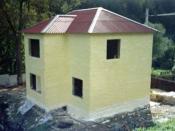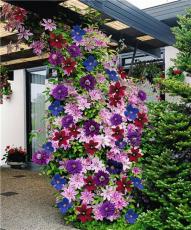Search
Login
Recommended
How to plant clematis in order to ensure abundant flowering of clematis. Care, dressing, watering clematis
A special place in the decorative design of suburban areas is occupied by clematis. This is an amazingly beautiful liana plant with a variety of colors, a unique texture and shape, as well as a unique aroma.
Due to the large number of different types of clematis, this flower has become an almost indispensable element in landscape design, allowing you to transform the walls of the building, hedges, arches and bring brightness to the design of a garden or flower bed.
Content
- Clematis: a variety of species of noble buttercup
- Features of planting clematis
- Clematis Care Highlights
- Methods of breeding clematis video
- The use of clematis in landscape design video
Clematis: a variety of species of noble buttercup
Clematis belong to the Ranunculaceae family, but have a number of advantages over their wild relative and are used to ennoble, decorate gardens and suburban areas. Therefore, this flower is also called a noble buttercup. Clematis is successfully grown in temperate and subtropical climates, and the middle strip of Russia is almost an ideal option for their reproduction.

The variety of varieties of perennial loach is divided into several groups based on their closest relative on the maternal side. Consider the seven main types of clematis:
- Jacquman varieties obtained by crossing the noble buttercup Jacquman with others. Basically, these are violet-purple flowers with a diameter of up to 20 cm. The height of the vines reaches four meters. Jacquans bloom on the new shoots of this year.
- Small-flowered clematis flower diameter not more than 4 cm; The main advantage of the varieties of this group is cold resistance. Small-flowered creepers are often used as ground cover plants.
- Patens (clematis sprawling) shrub vines, shoot length up to 3.5 meters. They are distinguished by a variety of colors from light tones to the brightest (violet-blue, purple). Clematis flowers (diameter about 15 cm) bloom in the spring on last year's shoots (sometimes in the summer on new shoots).

- Vititsella is a woody vine 4-5 meters high, grows quickly enough and tolerates frosty winters well. Clematis leaf plates reach 6 cm, and have 5-6 petals. Bloom profusely from June to September and can be used for both single and group plantings.
- Lanuginoza (wooly clematis) can bloom twice a year (the first flowering season is May-June, the second, less plentiful, July). Sepals are predominantly light tones (blue, pink or white). The height of the deciduous vine is about 2.5 meters, the leaf plate has a woolly texture on the bottom, and a smooth top.
- Florida varieties of this group do not like strong pruning, otherwise flowering will be very rare and late. Therefore, in the autumn, shoots are shortened to 1.5 meters and sheltered for the winter. The length of the shoots of shrub liana is 3 meters, the diameter of the flowers is 8-12 cm.
- Integrifolia (whole leaf clematis) shrubs with a height of 1.5 meters, practically do not weave and poorly cling to the supports. Flowers, usually bell-shaped, with a diameter of up to 12 cm.

In the vertical gardening of the garden, hundreds of varieties of clematis are involved, different in color, texture of the petals, length of shoots and some features in the care.
Features of planting clematis
good planting material guarantee of abundant and long flowering
In order for clematis to please the owners and guests of the garden plot with their abundance for a long time bright flowers, it is necessary to take care of the quality of planting material in advance.
First of all, you need to decide how to plant clematis: seeds or finished seedlings.

In the first case, when buying seeds, it is important to consider the following points:
- at home, it is better to sow small-flowered clematis;
- flower seeds need stratification (ripened seeds are exposed to cold temperature);
- when buying seeds, it is better to give preference to the products of recommended manufacturers supplying planting material of various garden crops;
- seeds collected from own plants must be stored in a dark place before planting.

Purchased clematis seedlings must meet the following requirements:
- on plants there should be no mechanical damage, signs of disease or the presence of pests;
- high-quality planting material will have a well-developed root system (at least 5 roots);
- a plant purchased in autumn should have at least two developed shoots with buds, one in spring;
- in autumn, it is better to buy seedlings not earlier than mid-September; in spring and summer, seedlings are sold less often;
- it is better to choose biennial plants with a closed root;
- clematis seedlings obtained by grafting on wild-growing species are not subject to sale;
- when buying, pay attention to the variety of the flower and the requirements for planting and care for it.
selection and preparation of the optimal landing site
Clematis can grow in one place for more than 20 years, so you need to choose a site for their planting very carefully.
Curly flower loves the sun, and therefore it is better to plant it on the south side of the site. The plant needs lighting for about 5-6 hours per day. For most varieties, this is one of the main conditions for rapid flowering and active growth. Biennial varieties of perennials prefer to grow in partial shade.
The composition of the soil clematis unpretentious. The only thing to consider is that they cannot tolerate marshy, moist soil. Therefore, it is necessary to choose a site located on a small hill, this will protect the plants from flooding in the spring.

It is necessary to equip the supports for clematis, along which the plant will curl. It can be an arch, a nearby tree, trellises, a wall of a gazebo or a railing of a staircase. Choosing this or that support, it must be remembered that for the winter, the branches of clematis will need to be removed and insulated, so the design should not be too complicated. To decorate an intricate support, it is better to use varieties of clematis, which do not need thorough trimming.
You can not plant clematis near the summer cottages with a corner roof, in order to avoid getting rainwater drain on the root of the plant’s neck. It is necessary to maintain a minimum distance of half a meter
favorable landing time

In regions with a temperate climate (southern regions and the middle zone of Russia), clematis are planted in autumn in the first decade of September. The plant has time to take root and overwinter safely.
If, in the region, frost begins already with the onset of October (northern regions), then planting should be postponed to spring, namely, at the end of April and the beginning of May. In this case, clematis will please bloom only next year.
The exception is potted clematis from the age of three years, which have a fairly strong root system. These flowers are able to withstand low temperatures, so they can be planted for the winter.
landing process
We divide the process of planting clematis into the following stages:
- Dig out a volumetric hole for landing (depth 70 cm, diameter 60 cm); it is advisable to do this in advance (per day) in order to protect the delicate roots of the plant from burns with mineral fertilizers.
- The bottom of the pit should be covered with a layer of gravel, pebble and brick (layer thickness of about 20 cm).
- The pit is filled with nutrient soil (one part of sand, peat and two parts of organic fertilizer will go to 2 parts of the earth).
- At the bottom of the pit pour a mound from the ground and place clematis on it, gently spreading the roots.

- The root neck should be at a depth of 10 cm.

- Water the soil abundantly.
After a while, around clematis, it is desirable to plant stunted flowers that protect the roots from excess light.
Clematis Care Highlights
Most garden plants need regular and gentle care, and clematis is no exception. Planting and caring for a perennial flower is very interconnected: top dressing, watering and pruning are directly dependent on the growing season of the plant.
flower care after planting
In the first year after planting, the plant should not be abundantly fertilized, as this is fraught with damage or death of clematis.
With prolonged rainy weather, in order to prevent root rot, you can sprinkle the root part of the trunk with wood ash.

If there is a possibility of overdrying the soil, then it can be mulched with humus or with a moss to cover the area around the flower with material that lets air through and regulates the moisture and temperature of the soil.
As a fertilizer for a young plant, you can use copper solution or Strawberry concentrate.
pruning, dressing and watering clematis
Attentive attitude to flowers will be the key to the beauty of the infield and provide abundant flowering clematis. Growing plants is impossible without knowledge of pruning rules, the frequency of fertilizing and irrigation standards.

The procedure for trimming clematis depends on the variety of decorative creeper:
- The first group of flowers are formed on last year's shoots. Need pruning only with a strong growth of the bush. In autumn, before the onset of frost, old and weak shoots are cut off.
- The second group of pruning is carried out in two stages: in spring, flowering shoots of last year are removed, in autumn, the weakest shoots are cut.
- The third group of plants, giving the main color from young shoots. Cut clematis in spring to the height of the first kidney from ground level.
After circumcision, clematis must be insulated by covering the remaining shoots with a layer of earth and peat. Sensitive varieties are covered from above with spruce branches, boards or roofing felt. This will protect the bark of the plant from freezing and excessive moisture.
Clematis must be fed in the spring. You can water the plant with milk of lime (10 grams of water 100 grams of slaked lime), a liquid solution of mullein. Useful for flowering vines will be watering with a copper solution: 10 liters of water + 1 tbsp. a spoon of copper.
Clematis gives the most abundant flowering for the first seven years, since later, fertilizers and water do not reach the overgrown roots. Therefore, some amateur gardeners dig pipes into the ground (when planting) through which all the necessary nutrients enter.

Decorative vines require regular watering every 7-10 days. Water should penetrate to a depth of 60-70 cm, but during normal irrigation, most of the water spreads over the surface. To solve this problem, around the bush, at a distance of 40 cm, they dig in ordinary flower pots, which are filled with water. Through the drainage hole, water gradually reaches the roots of clematis. This method helps to obtain large flowers even in plants older than seven years.
Methods of breeding clematis
To obtain clematis planting material, reproduction can occur in different ways:
- vegetative (division of the bush, reproduction by layering and cuttings);
- seeds (acceptable only for plants with small flowers).
The division of the bush can be carried out in the fifth or sixth year after planting. To do this, just dig out the bush and divide it into several parts. The advantage of the method is the fast flowering of a new shrub, and the main disadvantage is the probability of not rooting the bush and the transmission of diseases from the mother plant to it.
Most often, gardeners propagate clematis by cuttings. The method can be used in spring, autumn or even in winter (lignified cuttings).

The second most popular method of propagation of a noble seed buttercup. Let's consider in order how to plant clematis with seeds:
- The largest and strongest seeds are harvested.
- In the spring, before planting, the seeds undergo stratification (they are kept at a temperature of 0-5 degrees for three months).
- Seating boxes are covered with soil and sand in a ratio of 50/50.
- Seeds are poured on the ground and gently sprinkled with sand.
- The temperature for normal germination is 25-30 degrees.
- Seedlings should be in a bright place, but not in direct sunlight.

- With the appearance of the first leaves, clematis dive into beds (distance between plants 20 cm).
- Periodically, you need to pinch the shoots this will help develop the root system and increase the branching of the vine.
- In autumn, young clematis are sheltered, and in the spring they are transplanted into a trench (depth 7 cm, distance between flowers 45 cm). Shoots must be cut to 3 knots.
- The following year, clematis can be planted in a permanent place.
The use of clematis in landscape design
Clematis occupy a worthy place in landscape design, thanks to its long, plentiful and bright flowering. More often they are used as a vertical design.
The main applications of clematis in transforming the appearance of a garden plot and creating original compositions:
- decorative design of the walls of the house, arches, gates, etc. (almost any outbuilding can be masked);

- creation of a hedge as a fence of the site;
- decoration of tree trunks;
- design of alpine hills, alleys;

- single plantings or a combination with a common floral arrangement;
- use as a groundcover (horizontal) plant;
- creation of a clematis garden.
Clematis is a national favorite, ready to please the owners with beautiful flowering and intricate interweaving of vines. All the difficulties and nuances of caring for a noble buttercup are fully compensated by the festive atmosphere that these flowers create on the garden plot.





